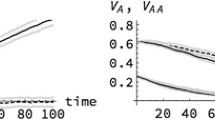Summary
Efficiency of indirect selection compared with that of direct selection to increase the mean value of some trait has been usually studied by considering a single generation of indirect and direct responses to selection only. However, under continued selection, genetic variances and covariances, and therefore expected genetic responses, change each generation due to linkage disequilibrium. With directional and truncation selection, genetic parameters asymptote to limiting values after several generations. The efficiency of indirect selection is examined in this limiting situation. The ratio of correlated response to direct response for the trait to improve in the limit is compared with the ratio after the first generation of selection. For all initial parameter values for which indirect selection is more efficient than direct selection, relative efficiency of indirect selection is smaller in the limit than in the first generation. For some parameter values, indirect selection is more efficient than direct selection in the first generation, but less efficient in the limit. Expressions for minimum values of the initial genetic correlation and heritability of the alternative trait required for indirect selection to be preferred in the limit are derived. These values are higher when limiting responses are used instead of single generation responses. The loss in relative efficiency of indirect selection from changes in genetic parameters due to selection should be taken into account when applications of indirect selection are considered.
Similar content being viewed by others
References
Bulmer MG (1971) The effect of selection on genetic variability. Am Nat 105:201–211
Bulmer MG (1980) The mathematical theory of quantitative genetics. Clarendon Press, Oxford
Falconer DS (1952) The problem of environment and selection. Am Nat 86:293–298
Falconer DS (1981) Introduction to quantitative genetics, 2nd edn. Longman, New York
Gomez-Raya L, Burnside EB (1990) The effect of repeated cycles of selection on genetic variance, heritability, and response. Theor Appl Genet 79:568–574
Lerner IM, Cruden DM (1948) The heritability of accumulative monthly and annual egg production. Poultry Sci 27:67–77
Searle SR (1965) The value of indirect selection: I. Mass selection. Biometrics 21:682–707
Villanueva B, Kennedy BW (1990a) Effect of selection on genetic parameters of correlated traits. Theor Appl Genet (in press)
Villanueva B, Kennedy BW (1990b) Efficiency of indirect selection with a finite number of loci. In: Proc 4th World Congr Genet Appl Livest Prod, Edinburgh Vol XIII: 265–268
Walkley JRW, Smith C (1980) The use of physiological traits in genetic selection for litter size in sheep. J Reprod Fert 59:83–88
Woolliams JA, Smith C (1988) The value of indicator traits in the genetic improvement of dairy cattle. Anim Prod 46: 333–345
Wray NR, Hill WG (1989) Asymptotic rates of response from index selection. Anim Prod 49:217–227
Author information
Authors and Affiliations
Additional information
Communicated by D. Van Vleck
Rights and permissions
About this article
Cite this article
Villanueva, B., Kennedy, B.W. Efficiency of indirect selection at selection equilibrium. Theoret. Appl. Genetics 81, 166–172 (1991). https://doi.org/10.1007/BF00215719
Received:
Accepted:
Issue Date:
DOI: https://doi.org/10.1007/BF00215719




